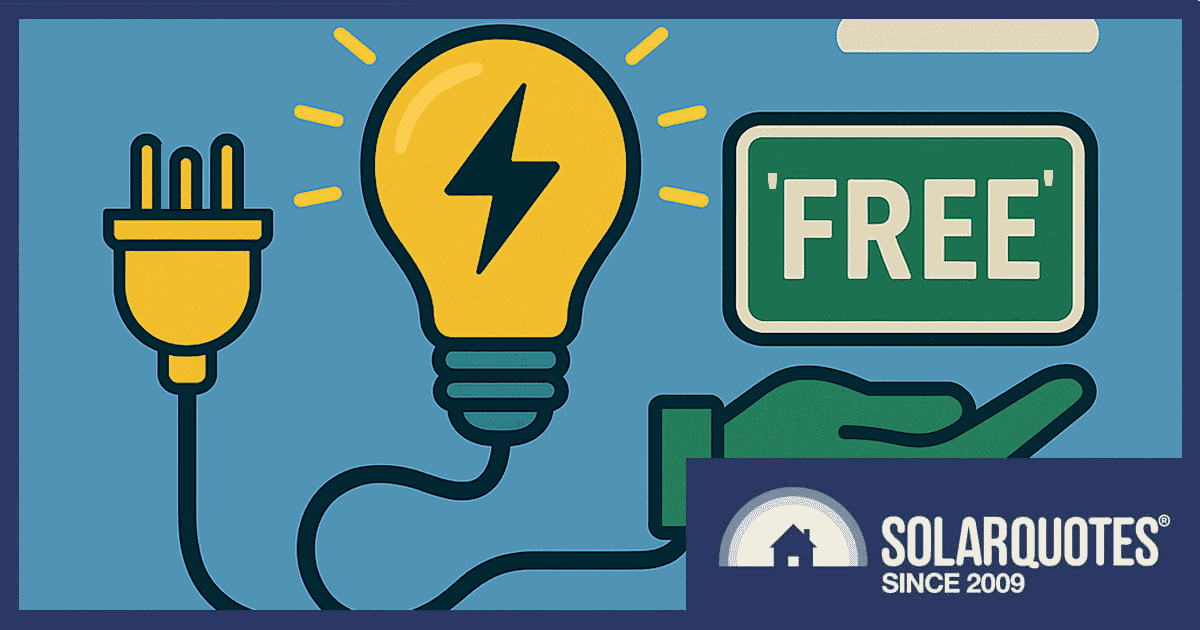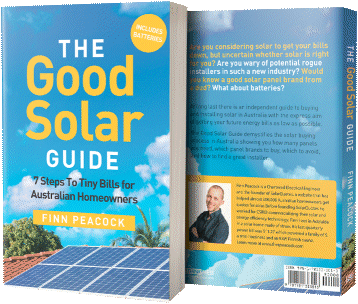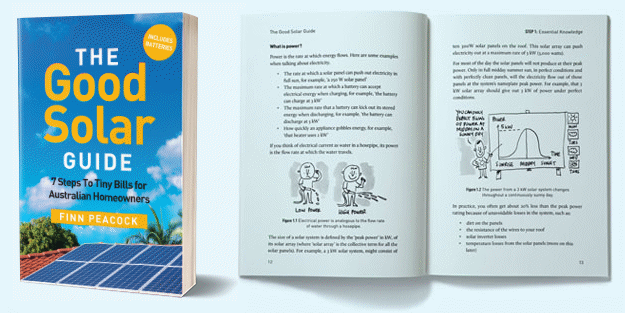Energy retailer AGL is offering a new residential power plan offering three hours of ‘free’ electricity each day. It sounds like a good deal, but is it? Plus, news on AGL’s latest VPP venture.
Launched last week and initially available to South Australian households with a smart meter, the “Three for Free” plan provides free electricity usage from 10am to 1pm daily.
“The Three for Free plan is about giving more Australians the opportunity to access similar benefits as someone who has solar that is self-consuming in the middle of the day,” said AGL’s Chief Customer Officer Jo Egan. “Customers on the plan who shift their energy use can create savings on their electricity bills, they don’t need to install solar panels to reduce their energy usage costs during daylight hours.”
Part of the reason AGL can offer ‘free’ electricity is thanks to the many households and businesses that have already installed solar panels. So much capacity has been added over the years that it has pushed down wholesale power prices during that time window, with negative prices becoming more common. It’s an example of the broader community benefits that rooftop solar power can bring.
The Three For Free plan might also be of interest to solar owners — those with small systems, or for days when the weather is unfavourable for solar energy generation, or for a helping hand topping up a home battery1 or electric vehicle.
But is it a good deal for either group?
Three For Free Plan Comparison
Comparing Three For Free with AGL’s Residential Smart Saver on a flat rate tariff plan in my neck of the woods shows:
| Plan | Three For Free | Smart Saver |
|---|---|---|
| Supply Charge | 127.69c/day | 108.03c/day |
| Usage Charge | 47.73c/kWh | 43.63c/kWh |
| Solar Feed-In | 2c/kWh | 2c/kWh |
Comparing Time of Use (ToU) rates between the plans also shows Three For Free has more expensive rates. It’s same difference on the supply charge as with the flat rate plan but less of a gap in terms of usage rates for the different periods. And in all cases, the solar feed-in tariff certainly isn’t anything to get excited about.
Whether “three for free” type plans work out cheaper will depend on how a non-solar household utilises them. But if you own a modest solar power system — or are thinking about skipping solar panels altogether2 — and considering buying a large battery system to charge for free during the window to help power your home for the remainder of day/night, consider what SolarQuotes founder Finn Peacock had to say recently.
Still, it’s interesting to see more of these types of plans introduced.
Of course, AGL isn’t the only show in town. You can see how energy retailer plans stack up against each other using the SolarQuotes electricity plan comparison tool. If you haven’t compared plans for a while, it’s a good idea to. Late last year, the Australian Competition and Consumer Commission (ACCC) estimated over 80% of National Electricity Market (NEM) households are paying more for electricity than they need to; with households on offers over a year old paying on average $238 more annually than those on newer offers.
The Three for Free plan is part of AGL’s Community Power program — and on that note, on to some other recent AGL news.
AGL To Roll Out More Community Batteries
On Tuesday, AGL announced it is to build and operate 16 community batteries in South Australia as part of its Community Power program. AGL says the initiative will provide cheaper electricity to more than 10,000 low-income and energy hardship households through an energy plan priced at 25 percent below the current SA default market offer (DMO). The 700 kW / 1828 kWh batteries will join AGL’s Virtual Power Plant (VPP).
“Consumer energy resources like rooftop solar play an incredibly important role in the energy transition, representing an increasing part of Australia’s total energy generation,” said Egan. “If we can use these resources more effectively and efficiently, in ways like community batteries and virtual power plants, this will help us provide more affordable energy to some of the customers who need it the most.”
The Empowering SA initiative is being delivered in partnership with the SA Government, and is also getting federal support. The Australian Renewable Energy Agency (ARENA) is providing funding of approximately $11 million for the project, with AGL kicking in $4 million.
The announcement follows AGL’s recent acquisition of South Australia’s Virtual Power Plant (SA VPP) from Tesla.
Virtual Power Plants are getting more attention given the federal government battery rebate requires batteries to be VPP-capable (but you don’t have to join one), the NSW government is offering a VPP incentive, and WA’s solar battery rebate requires VPP participation.
You can learn more about the benefits and drawbacks of Virtual Power plants here, and see programs compared side-by-side on SolarQuotes’ VPP comparison table.
Footnotes
- Added: 5 August, 2025. After a comment from a reader, I looked at the terms and conditions for AGL’s plan again and it states: “If you have a home battery, it must be supplied by AGL and connected to our Virtual Power Plant.” ↩
- Added: Note that not having existing or new solar installed means no national battery rebate. ↩


 RSS - Posts
RSS - Posts



This sort of plan certainly makes a battery much more appealing. I hadn’t been considering it because most of my excess solar goes into making hot water via a Catch Green unit. But if I could charge a battery during the day for free… hmmm.
But how much can you charge a battery in 3 hours?
It depends on the size of your battery inverter and how many amps your mains feed is. If you have a single phase 63A supply and a 10kW battery inverter you can put 30kWh in over 3 hours with 4kW headroom for other appliances.
Just pointing out that the Federal battery subsidy requires the house to have solar installed. It doesn’t say how much solar, just that there is solar that has been through the STC subsidy scheme. In other words, you can’t just AC couple a battery and charge it during free grid power time slots without solar unless you forgo the battery subsidy.
I ran my actual usage data through my spreadsheet with 3 hours of daily free power programmed in. Over the space of a year I’d end up paying more compared to current AGL Solar Savers Plan….because of the increased supply charge and reduced Feed In Tariff.
Not such a great deal for me with a Tesla PW2 and 14.4kW Enphase PV system
recalculate it adding the cloudy and rainy days and smaller solar and larger battery and it does work out better at least 6-8 mth a year 🙂
Btw I have 8kW of IQ7+ “solar” so max 6.5kW peak and per day max 42kW produced at peak times of the year, winterbis half at best. Later I wentbwith two PW2s, in Sydney,
It made sense in winter for me with just the 1 PW2 given it takes in max 5kW. Added the second to be on 10kW in/out and charge both up to full no probs even with Tesla chopping down ingress feom 10kW to 6.7kW w/o any heads up approx. 2mth ago.
Now that we are heading to sunny days do I wonder where to next, what plan is better as I have added an EV and the fact EV plans have no “free lunch” just the 6h overnight at $0.08 per kW, it may make sense to switch plans multiple times a year 🙂 thanks to the global no lock in contarcts.
I am being told up to 10 kWh per phase per hour for free for three hours (i.e. 30 kWh for one phase systems, up to 90 kWh for a three phase wired house or other eligible building. This means I can charge a 50 kWh battery from 0 to 100% theoretically every day. It is hard to find details but checkou Ovo, AGL and Origin (and good luck to you!)
Depends on the inverteramong other things. I have a 10kw inverter and 3 phase house so that’s 30kwh max for 3 hours. The cap will be the battery size and how much solar is already producing. So right now I am only importing 5kwh max during the 3 hours as my spring usage is low and solar production is high relative to winter.
In Victoria OVO, Powershop and one other retailer offer 3 hours for free. One argument against getting a bigger battery that I saw on this website is that the retailer could pull the free power offer. That seems unlikely to me – the trend is more retailers offering free power windows. A better argument against getting a bigger battery is that the 3 hour free power window will become a free 5 hour power window (with maybe the daily charge increasing). I am mulling the size now. Have a 24kwh battery coming next week.
I have this in Melbourne with Ovo. It’s much cheaper overall though: 98c/day supply charge and 26c/kWh usage. Power is free from 11am-2pm. It makes heaps of sense as I’m a renter and for whatever reason the landlord has routed the electric hot water heater through the main meter instead of the controlled load heater. So now all my hot water (around 11 kWh a day) is free as I work from home and can be there to manually turn it on and off. I’m a special case though, it wouldn’t be of as much benefit to everyone out there.
I have a 24kwh battery with 6 kw inverter, and charge it to 18kwh for free using ovo energy in Melbourne. I also run the dishwasher during the free period from 11 a.,m. to 2p.m. every day. Solar panels easily finish of the full charge during the day. No vpp requirements- a great deal and cheaper than agl.
I too was with OVO but they ended up hiking their rates after 12 months with them, so moved to AGL. You get 🔩d always somewhere along the way.
Please, let me know when this program is available in NSW.
Thank you
A similar plan on Ovo is currently available in NSW. I checked my address and the rates came up as 117.81c/day supply charge and 38.23c/kWh for peak rates.
So cheaper than the AGL mentioned above.
My understanding is that when prices go negative during the day, the power retailers are paid to take the excess power. So it stands to reason that giving it to their consumers for free still provides them with a good profit margin.
Once we have adequate storage and renewables on line and the coal plants are gone, there wont be as big a need for this sort of negative pricing, and these free in the middle of the day plans will probably go away. But i would think that would be quite a few years away yet.
Not quite – the generation cost is only about half the cost per kWh the retailer must bear – so the retailer is almost certainly losing money on these 3 hours:
This is off topic and I apologise for that. It seems to me that most if not all of the electricity suppliers are non Sutley increasing the daily supply charges to almost $2,00 per day. Sometimes that is a major component of my electricity bill. I have solar panel and a battery as do millions of others, so now they have found another way to screw us.
Agree with your comment 100%. Summarises my position exactly. Am in the process of weighing up a VPP vs retailer with the lowest daily charge servicing Queensland to get the most savings.
Confirmed with AGL, this is only offered to people that have had a battery supplied by AGL, and the only ones they are doing now are Tesla and Sigenergy, no longer are Solaredge or LG batteries in their line up.
Les, thank you for flagging this. I’ve taken another look at the T&C’s and it confirms what you state about the battery needing to be supplied by AGL (and it needs to be connected to their VPP). I don’t know how I missed this the first time around. I’ve added a note to the article.
As far as I can tell, Ovo has no similar limitation. You just need a smart meter. The only other conditions I can find in their terms is:
“The Free 3 Plan requires that you pay for the electricity you use monthly in advance on a Bill Smoothing arrangement.”
“The Basic Free 3 Plan is billed in arrears.”
Might be worth checking them out.
Odd that Alan, as AGL owns OVO 100% as of last year.
OVO terms might need a deep dig, but I think you might be right.
Hi all, can anyone tell me which supplier in Corowa NSW 2646 area has the lowest daily supply charge at the moment and what plan that is?
That is the maximum charge on my power bill
We are on the Essential Energy Supply.
Cheers
Hi Robert,
Look up “Bill Hero” and see what they recommend.
There’s a link somewhere on the solarquotes sites that will get you a discount I think.
They guarantee to save you more than the subscription costs.
Will do Anthony, Thanks.
Hi
I’ve noticed Ovo with great rates in Victoria. However I did not see that they had a add-on battery offering and I looked at AGL bringing my 10.5kw PV system across to pair up to a battery Sungrow and Tesla PW3 options only available in Vic.
The PW3 is desired, but a bit beyond my $ budget.
The thing that made me pause for a further look around was the Sungrow battery stack could only be paired with a Sungrow 5kw inverter, regardless of the stack capacity. 12.8kw in my case and 10.5kw PV system size combination.
I was thinking of a larger inverter (N/A with AGL) for some PV growth capacity and throughput to the future all electric house and battery charge with the meager FIT revenue leftovers.
If someone can calculate the 5kw system balance with or without 3 for free, that would be appreciated as a current AGL offer.
PHEV charger may tip it?